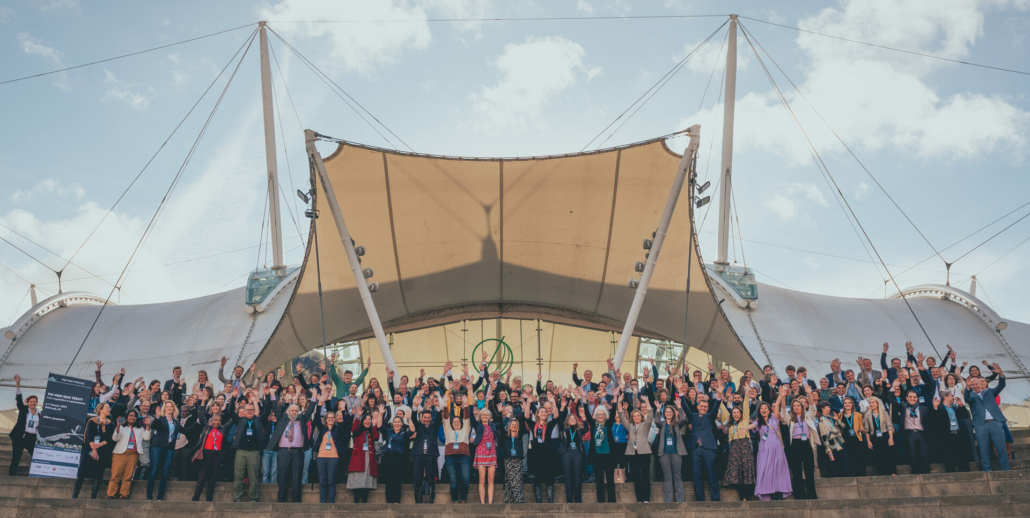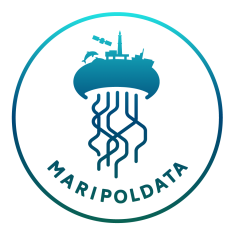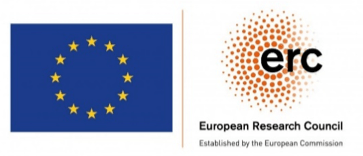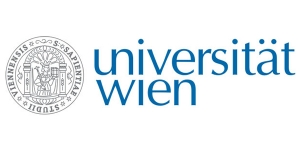The BBNJ treaty as a pioneer in genetic resource governance? Impressions from the Edinburgh High Seas Treaty Symposium
By Paul Dunshirn
Only a few months after the adoption of the new legally binding agreement on biodiversity beyond national jurisdiction (BBNJ) in June 2023, stakeholders met up for the ‘High Seas Treaty Symposium’ in Edinburgh on October 6th-7th. The Symposium brought together experts from policy, science, and conservation to discuss the first steps towards implementation and to deliberate on yet unresolved issues. This blog focuses on how marine genetic resources and digital sequence information (DSI) were discussed during the Symposium and reflects on the pioneering role that the BBNJ community may play in regulating the complex genetic resource policy field.

BBNJ stakeholders meeting in Edinburgh. Credits: https://jfdmedia.com/BBNJ Symposium 2023
The BBNJ agreement defines marine genetic resources as ‘any material of marine plant, animal, microbial or other origin containing functional units of heredity of actual or potential value’ (Art. 1.8). Being of crucial ecological importance to marine ecosystems, marine genetic resources are also frequently considered as highly valuable to biotech industries 1. One estimate [1] puts the market value of marine biotech at 6.4 billion US dollars by 2025. Importantly, it remains unclear how valuable specifically ‘BBNJ marine genetic resources’ are in comparison to those collected from coastal areas [2]. Against this background, BBNJ negotiators struggled for years to agree on a new governance system to regulate access and use of these resources. Positions were split about which types of benefits arising from biotech and science should be shared multilaterally [3], particularly whether ‘monetary benefits’ should be included, and to what extent such contributions should be based on a transparency or monitoring system [4]. A compromise was finally reached in March 2023, which included monetary benefits, yet without determining the exact modalities long-term (BBNJ agreement, part II). Importantly, negotiators also agreed to include DSI in the treaty alongside marine genetic resources (the latter being understood as genetic samples). There is currently no agreed definition of DSI, but it is generally understood as genetic sequence data (including at least DNA and RNA sequences [5]).
Just a few months after the Treaty’s adoption in June 2023, the Edinburgh High Seas Treaty Symposium allowed stakeholders to discuss implementation steps and unresolved issues. The Symposium’s principal sponsors were the deep sea research project iAtlantic, the NGO Marviva, the inter-governmental Sargasso Sea Commission, the Office français de la biodiversité, and a diverse group of other organisations. Amongst the other topics addressed by the BBNJ Treaty, marine genetic resources were high on the agenda and were the subject of the Symposium’s opening panel.
What still needs to be resolved?
Janine Coye-Felson, a Belizean delegate and facilitator on the marine genetic resources part, opened the marine genetic resource panel by reflecting on the divergence of positions that had to be overcome and identified aspects that require further deliberation. For instance, she pointed out that the Treaty defines obligations for Parties regarding notifications, traditional knowledge of Indigenous Peoples and local communities, and benefit-sharing while in most cases not prescribing how exactly these measures should be implemented. While some details are likely to be refined in the upcoming Conferences of the Parties (COPs), Janine Coye-Felson pointed out that this ‘bottom-up approach’ might lead to divergences in implementation. Such divergences might occur due to differences in national institutional and financial capacities to implement the measures. Other issues pointed out by Janine Coye-Felson included potential loopholes concerning fish and marine genetic resources, how diverging membership constellations to different genetic resource regimes (under the Convention on Biological Diversity (CBD), the World Health Organisation (WHO), and the Food and Agriculture Organisation (FAO)) will affect the implementation of BBNJ provisions, and how the specific issue of DSI will be governed across these regimes.

Marine genetic resources panel. Credits: https://jfdmedia.com/BBNJ Symposium 2023
How BBNJ will interact with other access and benefit-sharing regimes
Constituting the first legally binding agreement to regulate DSI, it is highly relevant to consider how the BBNJ framework will interact with other regimes. The participants of the marine genetic resource panel picked up on this issue. Gaute Voigt-Hanssen and Arianna Broggiato (negotiators of the genetic resource part for Norway and EU, respectively) emphasised the need to link the process under BBNJ to the Kunming-Montreal Global Biodiversity Framework (GBF) and the CBD decision on DSI, which the CBD state parties adopted in December 2022. Arianna Broggiato pointed out that scientific and private-sector stakeholders must be considered in this context. However, Siva Thambisetty (advisor to the Chair of the G77) noted that Parties to the BBNJ treaty are by no means obliged to wait for decisions on access and benefit-sharing on DSI to be made in other fora. Instead, the Treaty could be a pioneer in the complex field of data governance and genetic resources that may inspire similar solutions in other contexts.
It should be emphasised that, beyond the topic of DSI, many general questions persist over how the BBNJ access and benefit-sharing system will interact with other regimes. In the view of the blog’s author, one relevant question is whether the Treaty will be considered an exception (a ‘specialised international access and benefit sharing instrument’) under the Nagoya Protocol (Art. 4.4), which is the CBD’s central instrument to regulate the collection and use of genetic materials within national jurisdiction. While frameworks like FAO’s Seed Treaty or WHO’s Pandemic Influenza Preparedness (PIP) framework are likely to be considered as such [6], it is unclear whether the BBNJ Treaty will similarly interact with the CBD system. In any case, a lot hinges also on how countries themselves will deal with potential interactions across regimes through their own domestic access and benefit-sharing laws.
The BBNJ Treaty advances ‘trendy’ solutions to complex policy challenges
Considering the longstanding impasse in advancing genetic resource governance during the BBNJ negotiations and under other regimes, it seems evident that negotiators had to find innovative solutions to agree on a final text. During the Symposium’s marine genetic resource panel, Gaute Voigt-Hanssen went ahead and described the Treaty’s approach to access and benefit-sharing as ‘trendy’, due to its focus on benefit-sharing and its comparatively light regulatory focus on access. In particular, he pointed out that the Treaty is positive for researchers because it refrains from obliging users to enter contracts when using resources. Access and benefit-sharing have historically been conceived as necessarily paired issues to achieve equitable and fair partnerships between resource providers and users. The usefulness of combining those two aspects has been questioned in various settings over the past years, particularly in the context of DSI [7,8].
In contrast, Siva Thambisetty argued that ‘access’ is central to various mechanisms of the BBNJ Treaty. She was referring to the ‘standardised BBNJ batch identifier’, which was proposed by the G77 during the latter stages of negotiation to facilitate a form of traceability that does not require heavy bureaucratic measures, yet facilitates benefit-sharing based on empirical evidence of access or use. Siva Thambisetty thus argued that the trendy nature of the Treaty lies not in its lightness on access, but in the extent to which it envisions technical solutions to overcome the longstanding divergence of issue positions on access and benefit-sharing.
The panel’s scientists (Muriel Rabone from the Natural History Museum London, Andre Abreu from the Tara Foundation, and host Marcel Jaspars from Aberdeen University) all agreed that the Treaty’s provisions on data governance are inspired by current good scientific practice and are thus unlikely to create extensive bureaucratic burdens for researchers. Nevertheless, Muriel Rabone emphasised the need to think carefully about how to implement the provisions in practice.
Implementation was picked up again at a workshop connected to the Symposium that was organised by the research project Deepend. This project aims to study the societal value of biodiversity in the deep sea and thus provide crucial information on how to implement and further develop international legal regimes such as the BBNJ agreement. As discussed during the workshop, the project aims to provide a space for exploring how the Treaty’s provisions can work in practice, both in terms of implementing standardised batch identifiers and when it comes to North-South research cooperation.
So what about corporate use of marine genetic resources? Author’s reflections
While the BBNJ genetic resource regime was designed in close coordination with ocean scientists and is thus closely aligned with scientific practice, implementation may turn out to be more difficult when it comes to corporate-type use of marine genetic resources and DSI. When it comes to corporate activities, a distinction can be broadly drawn between the commercialization of products and the claiming of intellectual property rights (IPR). Both types have been discussed during the BBNJ negotiations, but their relationship to the Treaty remains uncertain.
As Siva Thambisetty pointed out during the genetic resource panel, the Treaty does not include a separate article on IPR anymore, as no agreement could be found. However, both she and Gaute Voigt-Hanssen pointed out that the Treaty obliges Parties to report on the utilisation of resources under article 12.8, which includes granted patents and developed products. In this sense, activities such as patenting may retrospectively be considered in calculations on monetary benefit-sharing, if the COP decides so.
However, tracing the use of marine genetic resources in scientific databases, databanks and journals via the BBNJ batch identifier seems much easier to achieve than for corporate activities. Most scientific journals require researchers to upload their sequence data into the INSDC ecosystem, which in turn is stepping up requirements for the reporting of origin information. It is probably not very complicated to integrate the identifier in these efforts. No comparable transparency standards for identifying genetic resource origin exist in commercial or IPR-related domains [9,10]. Some countries oblige patent applicants to disclose origins [11], but this doesn’t apply to many other countries and it remains unclear whether WIPO will agree on new international standards. Genetic sequences mentioned in patents could be linked back to their entries in scientific databases (and thus to their origin information) [12], particularly if their accession numbers are reported correctly, but it is unclear how reliable of a solution this would be.
Overall, it is a highly relevant question how the BBNJ treaty will relate to the private sector. Notably, the panel on industry implications, which included Jane Eva Collins (KPMG) and J.B. Jouffray (Stanford University) seemed to agree that private biotechnology companies are unlikely to be immediately affected by the Treaty. However, including considerations of private sector benefits from genetic resources in the overall access and benefit-sharing scheme under BBNJ is arguably a crucial element of equitable benefit-sharing. While this is foreseen in the Treaty and more specifically in the idea of the batch identifier, it appears that more consideration will be needed on how exactly to implement Parties’ obligations to report on the corporate use of marine genetic resources and DSI. Jane Eva Collins also pointed out that it would be useful to start considering how exactly to mobilise private stakeholders to participate in the implementation of the Treaty.
What happens next?
The BBNJ Treaty will enter into force 120 days after the 60th country has ratified it. The first COP meeting should follow soon after, where, amongst other things, the details of the described access and benefit-sharing system will be further sketched out. Until then, it is important to keep the conversations flowing and for Parties and stakeholders to start working on implementation. Capacity-building and stakeholder cooperation will be crucial to achieve effective implementation on a global level [13]. Mobilisation of stakeholders, including scientists and private actors should be considered an important element in these efforts. As highlighted in this blog, creating effective interlinkages between different genetic resource regimes will also be crucial. The upcoming CBD open-ended working group on DSI, held in Geneva from November 14th to 18th, will be an interesting opportunity to observe whether and how the BBNJ Treaty will affect current developments in the broader genetic resources governance field.
References
- Hurst, D., Børresen, T., Almesjö, L., Raedemaecker, F. & Bergseth, S. Marine Biotechnology Strategic Research and Innovation Roadmap – Insights to the future direction of European marine biotechnology. (Marine Biotechnology ERA-NET, 2016).
- Oldham, P. et al. Valuing the Deep: Marine Genetic Resources in Areas Beyond National Jurisdiction. https://bookdown.org/poldham/valuingthedeep/ (2014).
- Vadrot, A. B. M., Langlet, A. & Tessnow-von Wysocki, I. Who owns marine biodiversity? Contesting the world order through the ‘common heritage of humankind’ principle. Environmental Politics 31, 226–250 (2021).
- Langlet, A. & Dunshirn, P. Traceability options for marine genetic resource from areas beyond national jurisdiction. https://www.highseasalliance.org/wp-content/uploads/2023/02/traceability-options-paper-1.pdf (2023).
- Houssen, W., Sara, R. & Jaspars, M. Digital sequence information on genetic resources: concept, scope and current use. https://www.cbd.int/doc/c/fef9/2f90/70f037ccc5da885dfb293e88/dsi-ahteg-2020-01-03-en.pdf (2020).
- Lawson, C., Rourke, M. & Humphries, F. Information as the latest site of conflict in the ongoing contests about access to and sharing the benefits from exploiting genetic resources. Queen Mary Journal of Intellectual Property 10, 7–33 (2020).
- Scholz, A. H. et al. Multilateral benefit-sharing from digital sequence information will support both science and biodiversity conservation. Nat Commun 13, 1086 (2022).
- Aubry, S. The Future of Digital Sequence Information for Plant Genetic Resources for Food and Agriculture. Frontiers in Plant Science 10, (2019).
- Rohden, F., Huang, S., Dröge, G. & Scholz, A. H. Combined study on digital sequence information in public and private databases and traceability. https://www.cbd.int/abs/DSI-peer/Study-Traceability-databases.pdf (2020).
- Blasiak, R., Jouffray, J.-B., Wabnitz, C. C. C. & Österblom, H. Scientists Should Disclose Origin in Marine Gene Patents. Trends in Ecology & Evolution 34, 392–395 (2019).
- Humphries, F., Rabone, M. & Jaspars, M. Traceability Approaches for Marine Genetic Resources Under the Proposed Ocean (BBNJ) Treaty. Front. Mar. Sci. 8, 661313 (2021).
- Oldham, P. & Thambisetty, S. ONEST: The Middle way for Monetary Benefit Sharing in BBNJ Negotiations. https://zenodo.org/record/7573700 (2023) doi:10.5281/zenodo.7573700.
- Gjerde, K. M. et al. Getting beyond yes: fast-tracking implementation of the United Nations agreement for marine biodiversity beyond national jurisdiction. npj Ocean Sustain 1, 1–8 (2022).


